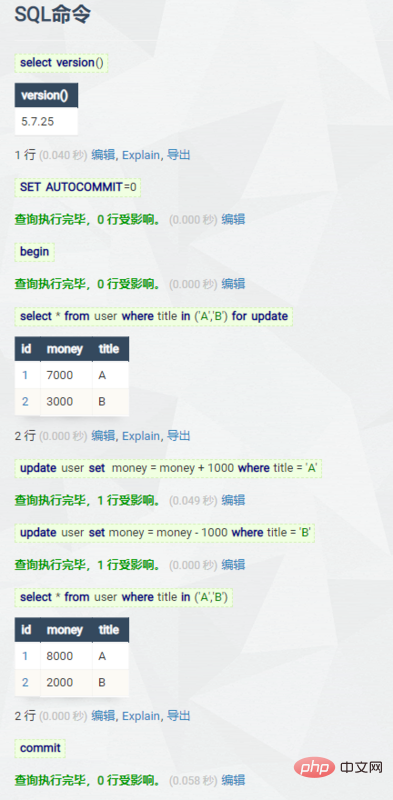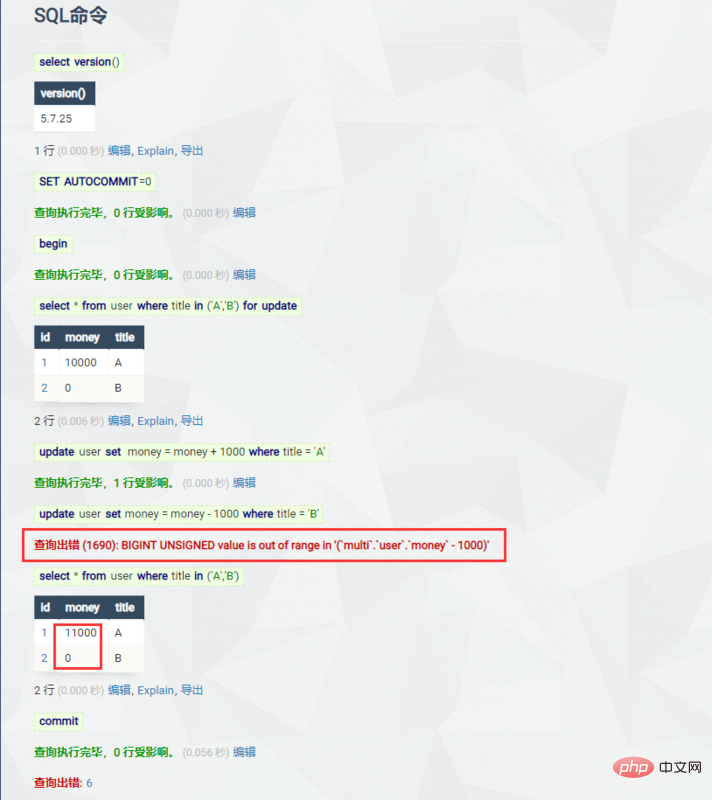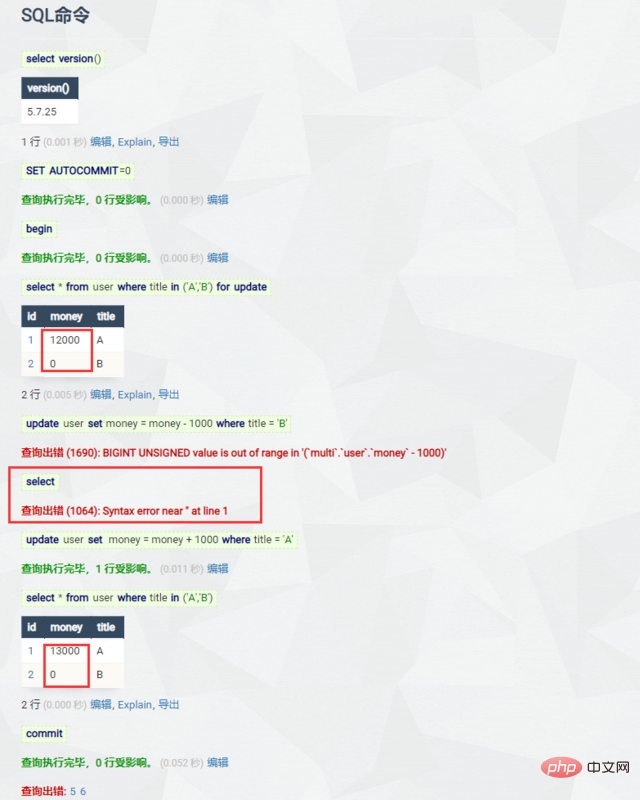
The content of this article is about the comparison of MySQL and Redis transactions (pictures and texts). It has certain reference value. Friends in need can refer to it. I hope it will be helpful to you.
In short: Generally speaking, transactions must meet four conditions (ACID): atomicity (Atomicity, or indivisibility), consistency (Consistency), isolation (Isolation, also known as independence), durability (Durability).
Judging from the title, since they are both transactions, what is the difference between them? Let’s unravel them one by one, starting with the two databases.
MySQL belongs torelational database, and Redis belongs tonon-relational database. They have different interpretations of transactions.
(Related recommendations:MySQL Tutorial,Redis Tutorial)
[1] Redis transactions can execute multiple transactions at one time command, and comes with the following two important guarantees:
A transaction will go through the following three stages from start to execution:
The execution of a single Redis command is atomic, but Redis does not add any mechanism to maintain atomicity on the transaction, so the execution of the Redis transaction is not atomic.
A transaction can be understood as a packaged batch execution script, but batch instructions are not atomic operations. The failure of an instruction in the middle will not cause the rollback of the previous instructions, nor It will not cause subsequent instructions not to be executed.
It seems a bit convoluted, so let’s actually execute it and see the results.
127.0.0.1:6379> multi OK 127.0.0.1:6379> set tr_1 233 QUEUED 127.0.0.1:6379> lpush tr_1 666 QUEUED 127.0.0.1:6379> set tr_2 888 QUEUED 127.0.0.1:6379> exec 1) OK 2) (error) WRONGTYPE Operation against a key holding the wrong kind of value 3) OK
In the above transaction, a string data with keytr_1is set, and then elements are added throughlpush. This is obviously wrong. Operation mode, when we submit the transaction, anoperation erroroccurs. At this time, let’s take a look at the value oftr_1.
127.0.0.1:6379> get tr_1 "233"
The content oftr_1obtained through thegetcommand is still233and has not changed. Let’s take a look at the others.
127.0.0.1:6379> keys * 1) "tr_2" 2) "tr_1" 127.0.0.1:6379> get tr_2 "888" 127.0.0.1:6379>
Here you can see thattr_2exists and the value is printed. At this time, we found that even if anoperation erroroccurred, the error did notNoCauses the execution to stop, and the statement after the error is also executed and executed successfully, which seems to be in line with the above mentionedThe failure of a certain instruction in the middle will not cause the rollback of the previous instruction, nor will it cause subsequent instructions Don't do it.
NO~, there is another situation at this timeSyntax error
127.0.0.1:6379> multi OK 127.0.0.1:6379> set tr_1 233 QUEUED 127.0.0.1:6379> lpush tr_1 666 QUEUED 127.0.0.1:6379> set (error) ERR wrong number of arguments for 'set' command 127.0.0.1:6379> set 233 (error) ERR wrong number of arguments for 'set' command 127.0.0.1:6379> set tr_2 888 QUEUED 127.0.0.1:6379> exec (error) EXECABORT Transaction discarded because of previous errors. 127.0.0.1:6379> keys * (empty list or set)
When we execute toNo parameters were given when setting, and one parameter was deliberately given during the second execution. You can see thatsyntax errorwas reported, and the transaction was finally submitted, which also told us that the transaction was lost due to the error. Then we usedkeys *to search and found that this was indeed the case.
Here you can find the
Errors inside a transaction mentioned in the official document
// You may encounter during execution to two wrong command errors.
During a transaction it is possible to encounter two kind of command errors:
//
1. The command cannot be entered into the queue, such as: wrong number of parameters, wrong command name ..., or some critical errors such as insufficient memory
- A command may fail to be queued, so there may be an error before EXEC is called. For instance the command may be syntactically wrong (wrong number of arguments, wrong command name, ...), or there may be some critical condition like an out of memory condition (if the server is configured to have a memory limit using the
maxmemorydirective).//
2. Perform wrong operations on keys, such as using lpush on strings above
- A command may failafterEXEC is called, for instance since we performed an operation against a key with the wrong value (like calling a list operation against a string value).
// The client checks the typed command, Most of the time, a
first typeerror will be found before callingexec. If the command execution returns QUEUED, it means that the command enters the queue normally. Otherwise, there is an error. In most cases, the client will terminate. Abandon this transaction.Clients used to sense the first kind of errors, happening before the EXEC call, by checking the return value of the queued command: if the command replies with QUEUED it was queued correctly, otherwise Redis returns an error. If there is an error while queueing a command, most clients will abort the transaction discarding it.
关于 Redis 暂时看到这里 接下来看到 MySQL
众所周知,MySQL 只有InnoDB 引擎支持 事务,在启用 MySQL 事务之前需要先停掉自动提交
user| 列 | 类型 | 注释 |
|---|---|---|
| id | int(11)自动增量 | 主键ID |
| money | int(11) [0] | 金钱 |
| title | varchar(500)NULL | 称呼 |
在这里来模拟一个转账的操作:A给B转100元。
步骤解析A+100 元,B-100元,即两步虽然很简单,简单走一下流程。

可以看到,没有问题,那么我们从中人为的制造一些问题呢?
| 列 | 类型 | 注释 |
| id | int(11)自动增量 | |
| money | int(11)unsigned [0] |
|
| title | varchar(500)NULL |
这里我们把money字段变成了无符号,即不能小于 0,并且,调整数据库中的数据如下。
`SELECT * FROM `user` LIMIT 50` (0.000 秒)
| 修改 | id | money | title |
|---|---|---|---|
| 编辑 | 1 | 10000 | A |
| 编辑 | 2 | 0 | B |
接着执行下面的 SQL
select version(); SET AUTOCOMMIT=0; begin; select * from user where title in ('A','B') for update; update user set money = money + 1000 where title = 'A'; update user set money = money - 1000 where title = 'B'; select * from user where title in ('A','B'); commit;

问题出现了,这里报出了错误,但是可以看到 前面的 SQL 已经是已执行的了,结果已经发生了变化,从这里看,似乎和 Redis 的处理差不多,除了错误之后语句继续执行。但是 值的注意的是, 在我们实际开发中,这种情况程序会直接抛出异常,以供我们在 catch 块中执行 rollback ,以回滚操作确保数据完整,即使是单独使用 MySQL 命令行 我们也可以用存储过程来对异常进行回滚。
刚刚看到 Redis 当遇到语法错误时会自动丢弃事务,阻止提交,那 MySQL 呢?

答案:不会,MySQL 在顺序执行时,如果未对异常进行处理,总会将成功执行的的提交,而不会触发自动终止,但是我们可以在程序执行时进行放弃提交。
Redis 的官方文档给出了这样的解释
// 只有在使用错误的语法调用时才会失败Redis命令(并且在命令排队期间无法检测到问题),或者对于持有错误数据类型的键,Redis命令可能会失败:这意味着实际上失败的命令是编程错误的结果,以及在开发过程中很可能检测到的一种错误,而不是在生产中。
- Redis commands can fail only if called with a wrong syntax (and the problem is not detectable during the command queueing), or against keys holding the wrong data type: this means that in practical terms a failing command is the result of a programming errors, and a kind of error that is very likely to be detected during development, and not in production.
// Redis内部简化且速度更快,因为它不需要回滚的能力。
- Redis is internally simplified and faster because it does not need the ability to roll back.
| 数据库 自动回滚条件 | 操作错误 | 语法错误 |
|---|---|---|
| MySQL | ✖ | ✖ |
| Redis | ✖ | ✔ |
但是 MySQL 支持手动回滚,实际开发过程中可以自行手动对已提交的操作进行回滚操作,更加友好。
The above is the detailed content of Comparison of MySQL and Redis transactions (picture and text). For more information, please follow other related articles on the PHP Chinese website!




